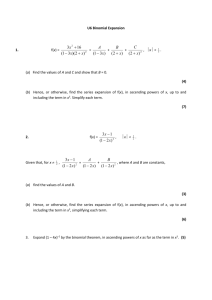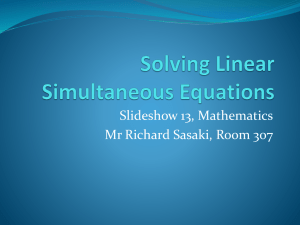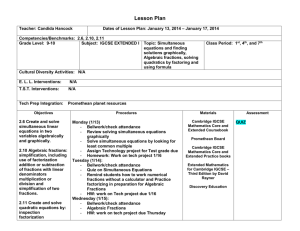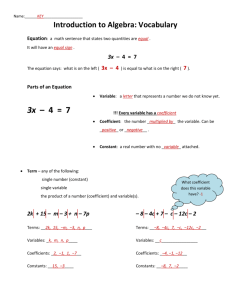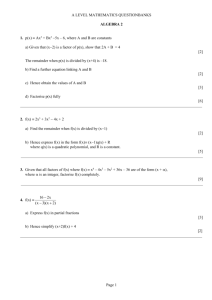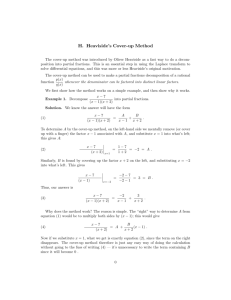Partial Fractions with answers.
advertisement
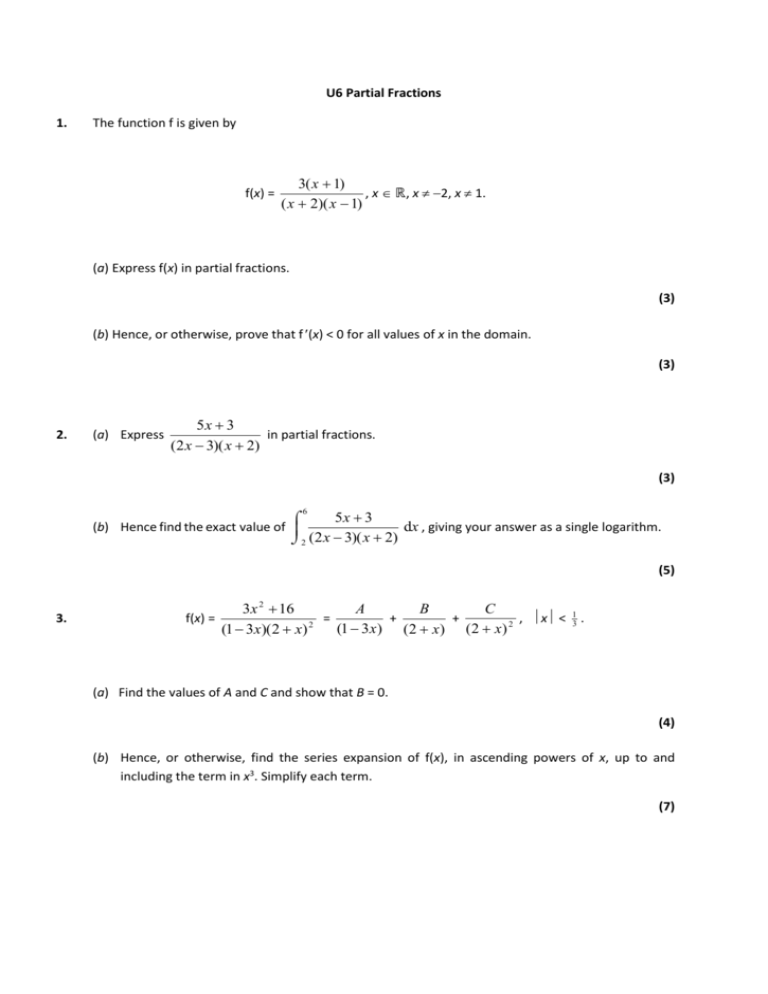
U6 Partial Fractions
1.
The function f is given by
f(x) =
3( x 1)
, x ℝ, x 2, x 1.
( x 2)( x 1)
(a) Express f(x) in partial fractions.
(3)
(b) Hence, or otherwise, prove that f (x) < 0 for all values of x in the domain.
(3)
2.
(a) Express
5x 3
in partial fractions.
(2 x 3)( x 2)
(3)
5x 3
(b) Hence find the exact value of
dx , giving your answer as a single logarithm.
2 (2 x 3)( x 2)
6
(5)
3.
f(x) =
C
3x 2 16
A
B
=
+
+
, x < 13 .
2
2
(1 3 x) ( 2 x ) ( 2 x )
(1 3x)( 2 x)
(a) Find the values of A and C and show that B = 0.
(4)
(b) Hence, or otherwise, find the series expansion of f(x), in ascending powers of x, up to and
including the term in x3. Simplify each term.
(7)
4.
f(x) =
9 4x 2
,
9 4x 2
x 32 .
(a) Find the values of the constants A, B and C such that
f(x) = A +
B
C
+
,
3 2x 3 2x
x 32 .
(4)
(b) Hence find the exact value of
9 4 x dx .
1 9 4 x 2
1
2
(5)
5.
f(x) =
Given that, for x
1
2
,
3x 1
,
(1 2 x ) 2
x <
1
2
.
3x 1
B
A
=
+
, where A and B are constants,
2
(1 2 x )
(1 2 x) (1 2 x ) 2
(a) find the values of A and B.
(3)
(b) Hence, or otherwise, find the series expansion of f(x), in ascending powers of x, up to and
including the term in x3, simplifying each term.
(6)
6.
U6 Partial Fractions Solutions
Question
Scheme
Marks
Number
1(a)
3( x 1)
A
B
, and correct method for finding A or B
( x 2)( x 1) x 2 x 1
M1
A = 1, B = 2
A1, A1
(3)
(b)
f ( x)
1
2
2
( x 2) ( x 1) 2
M1 A1
Argument for negative, including statement that square terms are
positive for all values of x. (f.t. on wrong values of A and B)
A1ft
(3)
2.
(a)
5x 3
A
B
2 x 3 x 2 2 x 3 x 2
5x 3 A x 2 B 2 x 3
Substituting x 2 or x 32 and obtaining A or B; or equating
coefficients and solving a pair of simultaneous equations to obtain A
or B.
A 3, B 1
M1
A1, A1
(3)
If the cover-up rule is used, give M1 A1 for the first of A or B found,
A1 for the second.
(b)
5x 3
3
dx ln 2 x 3 ln x 2
2
2 x 3 x 2
6
... 3 ln 9 ln 2
2 2
ln 54
cao
M1 A1ft
M1 A1
A1
(5)
[8]
3a. Considers 3x 2 16 A(2 x) 2 B(1 3x)(2 x) C (1 3x)
and substitutes x = –2 , or x = 1/3 ,
or compares coefficients and solves simultaneous equations
To obtain A = 3, and C = 4
Compares coefficients or uses simultaneous equation to show B = 0.
3b.Writes 3(1 3x) 1 4(2 x) 2
= 3(1 3x, 9 x 2 27 x3 ......) +
4
(2) x (2)(3) x (2)(3)(4) x
(1
+….)
4
1 2
1.2 2
1.2.3
2
2
3
= 4 8 x, 27 34 x 2 80 12 x 3 ...
Or uses (3x 2 16)(1 3x)1 (2 x) 2
(3x 2 16) (1 3x, 9 x 2 27 x3 )
(2) x (2)(3) x (2)(3)(4) x
¼ (1
)
1 2
1.2 2
1.2.3
2
2
= 4 8 x, 27 34 x 2 80 12 x 3 ...
3
4a.
9 4 x2
18
, so A = - 1
1
2
9 4x
(3 2 x)(3 2 x)
Uses 18 = B ( 3– 2x) + C ( 3+2x ) and attempts to find B and C
B = 3 and C = 3
Or
Uses 9 4x 2 = A( 9 4x 2 )+ B ( 3– 2x) + C ( 3+2x ) and attempts to find A, B and C
A = -1, B = 3 and C = 3
4b. Obtains Ax
B
C
ln(3 2 x) ln(3 2 x)
2
2
Substitutes limits and subtracts to give 2 A
= -2 +3ln5
or –2 +ln125
B
C
ln(5) ln( 15 )
2
2
Question
Number
5. (a)
Scheme
Marks
Considers this identity complete
and either substitutes
x = 12 , equates M1
3x − 1 ≡ A(1 − 2x) + B
coefficients or solves
simultaneous
equations
Let x = 21 ;
3
2
−1 = B
⇒ B=
1
2
Equate x terms; 3 = − 2A ⇒ A = − 32
(No working seen, but A and B correctly stated ⇒ award all
three marks. If one of A or B correctly stated give two out of
the three marks available for this part.)
f(x) = − 23 (1 − 2x)−1 +
1
2
A = − 32 ; B =
1
2
A1;A1
[3]
Moving powers to
top on any one of
the two expressions
(1 − 2x)−2
(b)
⎧
(−1)(−2)
(−1)(−2)(−3)
⎫
(−2x) 2 +
(−2x) 3 + ...⎬
= − 3 ⎨1 + (−1)(−2x); +
M1
Either 1± 2x or
1± 4x from either
expansions
respectively dM1;
Ignoring − 3 2 and
⎧
⎫
( −2)( −3)
( −2)( −3)( −4)
+ 12 ⎨1 + (−2)(−2x); +
(−2x)2 +
(−2x)3 + ...⎬
2!
3!
⎭
⎩
1
2
,
any one correct
{..........} expansion.
Both {..........}
A1
correct. A1
{
}
= − 32 1 + 2x + 4x 2 + 8x 3 + ... +
= −1 − x ; + 0x 2 + 4x 3
1
2
{1 + 4x + 12x
2
}
+ 32x 3 + ...
−1 − x ; (0x 2 ) + 4x 3
A1; A1
[6]
9 marks
